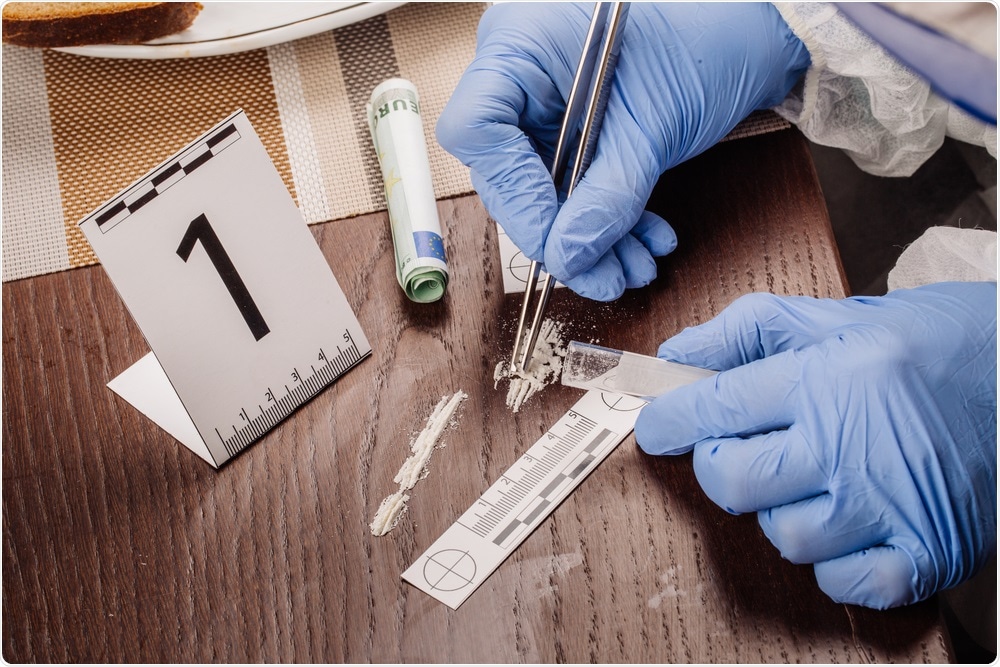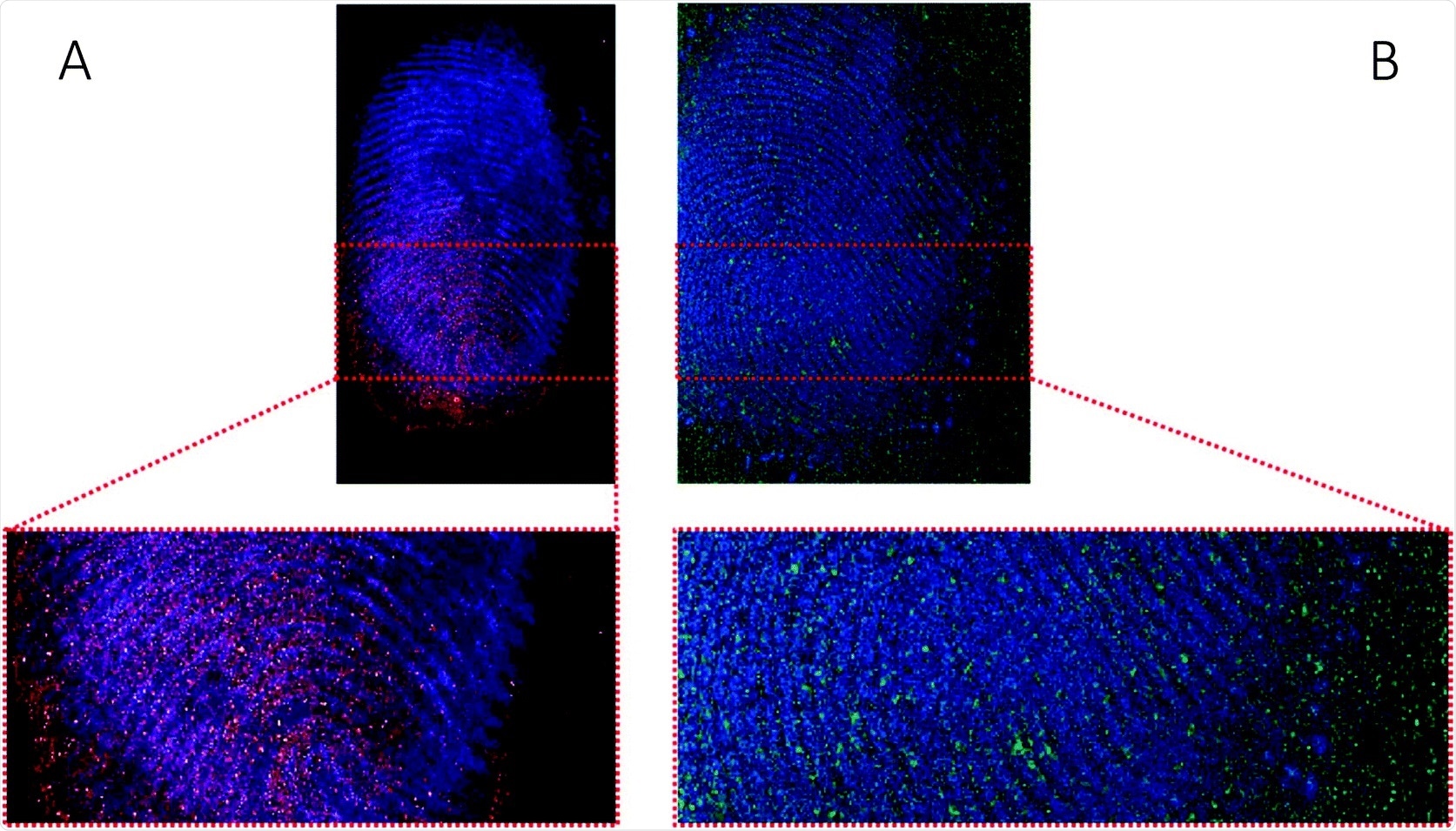In this interview, AZoLifeSciences speaks to Dr. Catia Costa about her latest research that showed how class A drug use can be determined from a single fingerprint.
Please could you introduce yourself and tell us about your career in forensics?
My name is Catia Costa. I have a degree in Chemistry with Forensic Investigation from the University of Surrey. My Ph.D. research project involved the development of a rapid and sensitive method for the detection of cocaine and its metabolites from a single fingerprint.
Since then, with my team at Surrey, we have been developing this technology by extending it to other substances (drugs of abuse, therapeutic drugs) and improving the methodology.
What role does drug use play in forensic crime scenes?
The relationship between drugs and crime is a long-standing point of research. Drug-related crimes can come in the form of [i]:
- Drug possession and consumption
- Drug manufacturing and distribution
- Theft, burglary, or fraud to get money to buy drugs
- Drug-related driving offenses
The discovery of drugs at a crime scene or in the bodily fluids of the victim/perpetrator can help narrow down motive and/or cause of death. Additionally, the detection of illicit substances in the victims or person of interest may elucidate the circumstances of the crime and the state of mind of those involved.

Drugs at Crime Scene. Image Credit: PRESSLAB/Shutterstock.com
How have advancements within fingerprint testing allowed this technique to be applied to other areas of forensics such as drug analysis?
Before we delve into fingerprints and their use in forensic cases, it is important to find out what makes a fingerprint. The skin of the fingertips is characterized by the presence of friction ridges, which are arranged in distinct and unique patterns.
The excretion of sweat through the pores in the fingertips leads to an accumulation of materials on the skin. These excreted substances (which will contain traces of prescribed medications, illicit substances, or foods ingested), as well as other substances, picked up by contact with other surfaces (e.g. oil secretions from the forehead) will transfer to any surface the fingertip touches with a pattern that mirrors the ridge arrangement.
Fingerprints have been routinely used in criminal investigations as evidence in the UK since the early 1900s. In most cases, fingerprints are used to identify people by matching the fingerprint patterns found at a crime scene with a database or fingerprints taken from suspects. This is based on three principles:
- Fingerprints are individual and not shared by two people (the likelihood of two people sharing the same fingerprints is one in many millions, even in twins)
- Fingerprints remain unchanged throughout life
- Fingerprints display a general pattern
Police forces will employ light sources and other chemicals to develop the fingerprint pattern, which is then captured and submitted for comparison. However, there will be cases where the offender is not on the database, or perhaps the fingerprint is only partially developed. It is in these cases that the chemical analysis of fingerprints may prove beneficial. Research into the chemical composition of fingerprints has shown that it can reveal drug use (both therapeutic and illicit) and even personal characteristics like gender and age.
A recent publication showcased how this might look with real casework samples[ii].
The ability to detect drug abuse from a fingerprint has applications well beyond generating the profile of the offender. The collection of fingerprints is much simpler, safer, and faster than the collection of body fluids like blood, urine, and saliva.
Additionally, there are no biohazards associated with fingerprint samples and the sample collection procedure is non-invasive (i.e. no needles; no need for privacy in the toilet). This makes fingerprints a good candidate for routine drug testing in the workplace, prisons, and even at airport security checkpoints. The fingerprint pattern can also be captured simultaneously, ensuring traceability and reducing the risk of cheating.
Can you describe how you carried out your latest research into drug use and fingerprints?
Over the years we have explored different ways to chemically profile fingerprints. We have used techniques such as paper spray[iii],[iv],[v],[vi] and liquid chromatography with mass spectrometry (LC-MS)[vii],[viii], which give a profile of the molecules present in the fingerprint residues. With these techniques, we have demonstrated the detection of cocaine, heroin, methamphetamines, and antipsychotic drugs iii, iv,v, vi, vii, viii.
To further study the feasibility of fingerprints as a drug-testing matrix, we have looked at the environmental levels of cocaine in the fingerprints of a drug-free population and set out to distinguish between someone who touched cocaine (bank notes are known to contain traces of cocaine so accidental contact is a possibility) and someone who ingested it. Both techniques are able to make that distinction, but require the hands to be washed prior to sample collection. Whilst this is acceptable in controlled environments like workplace testing, in forensic applications where the fingerprint is left at a crime scene, handwashing cannot be guaranteed.
Our latest publication[ix] employed a selection of techniques that not only profile the chemical composition of fingerprints but also show the distribution of said chemicals over the fingerprint pattern. Based on this distribution, we were able to differentiate between contact and ingestion without the need to cleanse the hands before sample collection. This approach can be used for fingerprints collected at crime scenes to further intel on the suspect and/or their environment.
What did you discover?
Let’s use cocaine as an example. When cocaine is ingested, it is broken down by the body into ‘metabolites’, namely benzoylecgonine (BZE). These metabolites and the parent drug are excreted in urine, sweat, and other body fluids. The detection of these metabolites in fingerprint sweat is not indicative of cocaine ingestion because as we reported in an earlier publication iv, street cocaine contains traces of BZE.
Thus, our latest study on the chemical imaging of cocaine and BZE in fingerprints showed how we can use the cocaine/BZE ratio AND the spatial distribution of the two molecules to distinguish between contact and ingestion. When someone takes cocaine we observed higher levels of BZE and almost uniform distribution of the substances over the fingerprint area. When someone touches cocaine, we observed higher amounts of cocaine and “spotty” distribution of the substances over the ridges. These observations are valid for fingerprints collected “as present” (no handwashing).

Study Results. Image Credit: Imaging mass spectrometry: a new way to distinguish dermal contact from administration of cocaine, using a single fingerprint
How is your research able to distinguish the differences between ingestion and touch?
Using non-imaging methods like paper spray and LC-MS, a distinction was based on fingerprints collected after handwashing based on the detection of BZE. Following this procedure, it was found that BZE was only detected in the fingerprints of donors who had ingested cocaine.
In another publication focused on the detection of heroin in fingerprints, we showed how secondary metabolites like morphine could be similarly used to distinguish between contact and ingestion vii.
In your previous research, you were able to determine the differences between touch and ingestion if the suspect had washed their hands prior to giving a sample. In your new research, the suspect does not need to have washed their hands. What advantages does this have for crime forensics?
As mentioned above, for routine drug testing the participant can be asked to wash their hands and even wear gloves for a period of time to induce sweating. However, at a crime scene, such procedures cannot be stipulated or followed. The conditions surrounding the deposition of a fingerprint in this scenario are largely unknown. Thus, it is important to have methodologies that can still provide information on the origin of the substance in the fingerprint.
Detection of drugs consistent with a contact scenario can suggest that the fingerprint donor is in a drug-contaminated environment (or perhaps handles contaminated banknotes?). Detection of drugs consistent with drug ingestion may help narrow down the list of suspects in the investigation.
Your fingerprint drug testing approach is based on high-resolution mass spectrometry. What advantages does this technique have over other analytical techniques available?
Mass spectrometry is widely used in forensics, especially in forensic toxicology. Mass spectrometry techniques can be used to separate, detect and identify whole molecules. This makes it invariably more selective (and in some cases more sensitive) than other analytical techniques like infrared and Raman spectroscopy.
As mentioned above, different modalities of mass spectrometry are available – imaging (which generates information on the spatial distribution of the analytes over the fingerprint area) – and non-imaging methods (where the fingerprint is “dissolved” and analyzed). The latter is more sensitive and akin to the approaches routinely used by forensic toxicologists.
How will your research aid crime scene investigations?
Further research into the relevance of using fingerprints for drug detection will enhance the knowledge obtained from fingerprint evidence recovered as part of criminal investigations. However, many other chemicals are concurrently excreted at the fingertips that can be useful in building a person’s profile, including age, gender, and ethnicity. The study of these other chemicals and the understanding of their persistence in fingerprints will help develop better and more efficient chemicals for the development of fingerprints recovered at crime scenes.
As we continue to explore imaging mass spectrometry methods, we hope to establish these techniques as alternative methods to develop fingerprints where conventional chemical approaches have failed to do so.
In fact, some of the techniques we investigated in our latest publication ix are already part of the Fingerprint Visualisation Manual produced by the UK Home Office which is used by all UK police forces. Whilst these techniques are still at a low maturity level for this application, further research will help increase the community’s confidence level in these new approaches.

Crime Scene. Image Credit: Prath/Shutterstock.com
What are the next steps for your research?
We will continue exploring the application of imaging mass spectrometry methods for the chemical profiling and imaging of fingerprints. This will hopefully result in the integration of these methods into routine police work.
From the fingerprint drug testing perspective, we hope to increase the range of substances that can be detected as well as developing approaches to quantify these substances. The ability to quantify substances present in fingerprints and relating levels to other matrices like blood will further establish fingerprints as a viable matrix for this application.
Where can readers find more information?
See a list of publications below.
[ii] Bradshaw R, Denison N, Francese S. Implementation of MALDI MS profiling and imaging methods for the analysis of real crime scene fingermarks. Analyst. 2017 May 2;142(9):1581-1590. doi: 10.1039/c7an00218a.
[iii] 10. Catia Costa, Cecile Frampas, Katherine A. Longman, Vladimir Palitsin, Mahado Ismail, Patrick Sears, Ramin Nilforooshan, Melanie J. Bailey (2019), ‘Paper spray screening and liquid chromatography/mass spectrometry confirmation for medication adherence testing: A two‐step process’. Rapid Commun Mass Spectrom., pp. 1-7. https://doi.org/10.1002/rcm.8553
[iv] 15. M. Jang, C. Costa, J. Bunch, B. Gibson, M. Ismail, V. Palitsin, R. Webb, M. Hudson & M. J. Bailey (2020). ‘On the relevance of cocaine detection in a fingerprint’, Scientific Reports, 10, article number 1974. https://doi.org/10.1038/s41598-020-58856-0
[v] Catia Costa, Roger Webb, Vladimir Palitsin, Mahado Ismail, Marcel de Puit, Samuel Atkinson, Melanie J Bailey (2017). ‘Rapid, Secure Drug Testing Using Fingerprint Development and Paper Spray Mass Spectrometry’, Clinical Chemistry, 63 (11), pp. 1745-1752. https://doi.org/10.1373/clinchem.2017.275578
[vi] Joanna Czerwinska, Min Jang, Catia Costa, Mark C. Parkin, Claire George, Andrew T. Kicman, Melanie J. Bailey, Paul I. Dargan and Vincenzo Abbate (2020). ‘Detection of mephedrone and its metabolites in fingerprints from a controlled human administration study by liquid chromatography-tandem mass spectrometry and paper spray-mass spectrometry’, Analyst, 145, pp. 3038-3048. https://doi.org/10.1039/C9AN02477H
[vii] Catia Costa, Mahado Ismail, Derek Stevenson, Brian Gibson, Roger Webb, Melanie Bailey (2020). ‘Distinguishing between Contact and Administration of Heroin from a Single Fingerprint using High Resolution Mass Spectrometry’, Journal of Analytical Toxicology, 44 (3), pp. 218-225. https://doi.org/10.1093/jat/bkz088
[viii] Mahado Ismail, Derek Stevenson, Catia Costa, Roger Webb, Marcel de Puit, Melanie Bailey (2018). ‘Noninvasive Detection of Cocaine and Heroin Use with Single Fingerprints: Determination of an Environmental Cutoff’, Clinical Chemistry, 64 (6), pp. 909-917. https://doi.org/10.1373/clinchem.2017.281469
[ix] C. Costa, M. Jang, J. M. de Jesus, R. T. Steven, C. J. Nikula, E. Elia, J. Bunch, A. Bellew, J. F. Watts, S. Hinder and M. Bailey (2021). ‘Imaging mass spectrometry : a new way to distinguish dermal contact from administration of cocaine, using a single fingerprint’, Analyst. DOI: 10.1039/D1AN00232E
[x] C. Costa, E. M. van Es, P. Sears, J. Bunch, Vladimir Palitsin, H. Cooper, M. J. Bailey (2019). ‘Exploring a route to a selective and sensitive portable system for explosive detection– swab spray ionisation coupled to of high-field assisted waveform ion mobility spectrometry (FAIMS)’, Forensic Science International: Synergy, 1, pp. 214-220. https://doi.org/10.1016/j.fsisyn.2019.07.009
[xi] Catia Costa, Elsje M. van Es, Patrick Sears, Josephine Bunch, Vladimir Palitsin, Kirsten Mosegaard, Melanie J. Bailey (2019). ‘Exploring Rapid, Sensitive and Reliable Detection of Trace Explosives Using Paper Spray Mass Spectrometry (PS‐MS)’, Propellants, Explosives, Pyrotechnics, 44 (8), pp. 1021-1027. https://doi.org/10.1002/prep.201800320
About Dr. Catia Costa
I am a Liaison Fellow at the Surrey Ion Beam Centre. The Surrey Ion Beam Centre (http://www.uknibc.co.uk/) is a UK National Facility funded by the Engineering and Physical Sciences Research Council (EPSRC). In addition to the fingerprint research mentioned above, I am involved in the development and application of ion beam technologies for a wide range of applications such as biology, materials science, and forensics. 
I am also involved in the application of novel mass spectrometry techniques (e.g. paper spray) for trace analysis, including the fingerprint work described above and rapid methods for explosives detection[x],[xi].